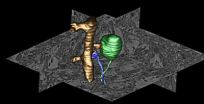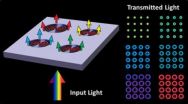(Press-News.org) The scientific and ethical debate over the use of animals in medical research has raged for years, but perspectives are shifting, viewpoints are becoming more nuanced, and new initiatives are seeking alternatives to animal testing, according to a special report by The Hastings Center, "Animal Research Ethics: Evolving Views and Practices." The report is available on a new Web site, animalresearch.thehastingscenter.org, a hub of educational information that defines and interprets this changing landscape.
These resources are the outcome of a project on the ethics of medical research with animals, which brought together people with different points of view and areas of expertise to share their knowledge and exchange ideas and insights. The project was led by Gregory Kaebnick, a research scholar at The Hastings Center; Thomas Murray, senior research scholar and President Emeritus; and Susan Gilbert, public affairs and communications manager.
"Our goal was to produce educational resources for a wide audience, including biomedical researchers, scholars, students, institutional animal care and use committees, policymakers, and journalists who follow animal research issues," says Kaebnick.
The special report, published with the Hastings Center Report, contains commentaries from the participants that cite examples of changes under way that are improving the welfare of animals in research and in some cases replacing them with alternative models.
One example is the recent set of limitations on the use of chimpanzees in federally-funded research. Jeffrey Kahn, who chaired the Institute of Medicine committee that recommended the limitations, discusses their implications and the decision by the National Institutes of Health to implement them. "The policy changes represent a watershed in animal research policy," writes Kahn, the Robert Henry Levi and Ryada Hecht Levi Professor of Bioethics and Public Policy in the Johns Hopkins Berman Institute of Bioethics. The recommendations "will impose the strongest restrictions to date on the use of any animal species for research in the United States, a major change in animal research policy in general."
Another example of change is a "paradigm shift" in toxicology testing that aims to replace animals with a process that uses human cells to study a chemical's "pathway of toxicity." Traditionally, rats and mice have been used to study the toxicity of new chemicals before they are tested in humans, but these experiments require large number of animals, take years to complete, and predict human toxicity only 43 percent of the time, writes Joanne Zurlo, director of science strategy for the Center for Alternatives to Animal Testing at the Johns Hopkins Bloomberg School of Public Health. She describes a new experimental approach that uses human cells to study a chemical's toxicity. "The paradigm shift in toxicology testing is the most significant force to date leading to the ultimate elimination of animal use for biomedical research and testing," Zurlo concludes.
A commentary by Kathleen Conlee and Andrew Rowan, senior officials at the Humane Society of the United States, argues that phasing out invasive research on nonhuman primates must be a priority for ethical, scientific, and economic reasons. The authors state that most nonhuman primate research is unnecessary and animal maintenance is expensive, with the government spending $1 billion of its $32 billion annual budget on the nation's primate research centers.
But Dr. D. Eugene Redmond, Jr., professor of psychiatry and neurosurgery at the Yale University School of Medicine, makes the case that nonhuman primates still play a vital role in key areas of medical research. Redmond, who studies Parkinson disease, says that the monkey model "is the best model we have and can predict benefits and side effects of new treatments."
Other authors are Larry Carbone, a veterinarian specializing in the care of laboratory animals; Susan Kopp, a veterinarian and professor of health sciences in the veterinary technology program at LaGuardia Community College, City University of New York, and a scholar at the Yale Interdisciplinary Center for Bioethics; Stephen R. Latham, director of the Interdisciplinary Center for Bioethics at Yale University; Joel Marks, professor emeritus of philosophy at the University of New Haven and co-director of the animal ethics study group at Yale; and Bernard E. Rollin, university distinguished professor, professor of philosophy, animal sciences, and biomedical sciences, and university bioethicist at Colorado State University.
Additional educational resources can be found on the Hastings animal research Web site, animalresearch.thehastingscenter.org, including statistics on the use of different animal species, alternative research models, links to other significant reports, animal studies programs, a selected and updated bibliography, and an interactive glossary of terms used in debates on research with animals that can have multiple meanings – such as the word "alternative." In the interest of fostering clear and civil discussion of the ethical controversies, The Hastings Center invites visitors to offer suggestions on the further development of the glossary.
INFORMATION:
The project was conducted by The Hastings Center in coordination with the Yale-Hastings Program in Ethics and Health Policy and supported with a grant from The Esther A. and Joseph Klingenstein Fund.
Contact: Susan Gilbert, public affairs and communications manager
The Hastings Center
845-424-4040 x244
gilberts@thehastingscenter.org
END
Researchers at the University of California, San Diego School of Medicine say overexpression of a protein called alpha-synuclein appears to disrupt vital recycling processes in neurons, starting with the terminal extensions of neurons and working its way back to the cells' center, with the potential consequence of progressive degeneration and eventual cell death.
The findings, published in the February 6, 2013 issue of the Journal of Neuroscience, have major implications for more fully understanding the causes and mechanisms of Parkinson's disease (PD), a neurodegenerative ...
VIDEO:
This video, created from a sequence of images from the Hubble Space Telescope, shows a pulse of light emanating from the protostellar object LRLL 54361. Most if not all of...
Click here for more information.
Two of NASA's great observatories, the Spitzer and Hubble space telescopes, have teamed up to uncover a mysterious infant star that behaves like a strobe light.
Every 25.34 days, the object, designated LRLL 54361, unleashes a burst of light. Although a similar ...
A recent study of the amphibians and reptiles of Sierra Madre Mountain Range, northeastern Luzon, reveals a preliminary enumeration of more than 100 species that contribute to the unique biodiversity of the region. At present, the Luzon region's herpetological range stands at more than 150 species. Out of these, a total of 49 amphibian species have been documented, 44 of which are native and a remarkable 32 endemic. In the world of reptiles, Luzon can boast with 106 native species, 76 of which are unique to this region.
The catalogue published in the open access journal ...
Tumourigenesis is driven by genetic alterations and by changes in the epigenome, for instance by the addition of methyl groups to cytosine bases in the DNA. A deeper understanding of the interaction between the genetic and epigenetic mechanisms is critical for the selection of tumour biomarkers and for the future development of therapies. Human tumour specimens and cell lines however contain a plethora of genetic and epigenetic changes, which complicate data analysis. In contrast, certain mouse tumour models contain only a single genetic mutation and allow the analysis ...
Researchers have identified a microRNA liver gene, miR-27b, which regulates lipid (cholesterol or fat) levels in the blood. This regulator gene controls multiple genes involved in dyslipidemia—abnormal blood cholesterol levels that can contribute to heart disease. Study details published in the February issue of Hepatology, a journal of the American Association for the Study of Liver Diseases (AASLD), describe a new in silico approach to identify the significance of microRNAs in regulating disease-related gene pathways.
The Human Genome Project (HGP) was completed in ...
CHESTNUT HILL, MA (February 7, 2013) – Using the geometric and material properties of a unique nanostructure, Boston College researchers have uncovered a novel photonic effect where surface plasmons interact with light to form "plasmonic halos" of selectable output color. The findings appear in the journal Nano Letters.
The novel nanostructure proved capable of manipulating electron waves known as surface plasmon polaritons, or SPPs, which were discovered in the 1950s but of late have garnered the attention of scientists for their potential applications in fields that ...
Chicago (February 7, 2013): Colorectal surgical patients are often discharged from the hospital with vague guidance on how to recognize complications, but researchers at the Michael DeBakey Veterans Administration (VA) Medical Center and Baylor College of Medicine, Houston, aim to change that scenario. A health services research team convened a panel of surgical experts to develop a list of postoperative complication signs that should prompt colorectal surgical patients to call their surgeons or go to an emergency room. The study on the development of this early patient-centered ...
The hippocampus – a structure of the brain whose shape resembles that of a seahorse – is also called the "gateway" to memory. This is where information is stored and retrieved. Its performance relies on new neurons being continually formed in the hippocampus over the entire lifetime. "However, in old age, production of new neurons dramatically decreases. This is considered to be among the causes of declining memory and learning ability", Prof. Dr. Ana Martin-Villalba, a neuroscientist, explains.
Martin-Villalba, who heads a research department at the German Cancer Research ...
(SACRAMENTO, Calif.) — Scientists have long puzzled over why "bad" bacteria such as E. coli can thrive in the guts of those with inflammatory bowel disease (IBD), causing serious diarrhea. Now UC Davis researchers have discovered the answer—one that may be the first step toward finding new and better treatments for IBD.
The researchers discovered a biological mechanism by which harmful bacteria grow, edge out beneficial bacteria and damage the gut in IBD. This new understanding, published in the Feb. 8 issue of Science, may help researchers develop new treatments for ...
Jacob Rutt is a bright 11-year-old who likes to draw detailed maps in his spare time. But the budding geographer has a hard time with physical skills most children take for granted -- running and climbing trees are beyond him, and even walking can be difficult. He was diagnosed with a form of muscular dystrophy known as Duchenne when he was two years old.
The disease affects about 1 in 3,500 newborns -- mostly boys -- worldwide. It usually becomes apparent in early childhood, as weakened skeletal muscles cause delays in milestones such as sitting and walking. Children ...




